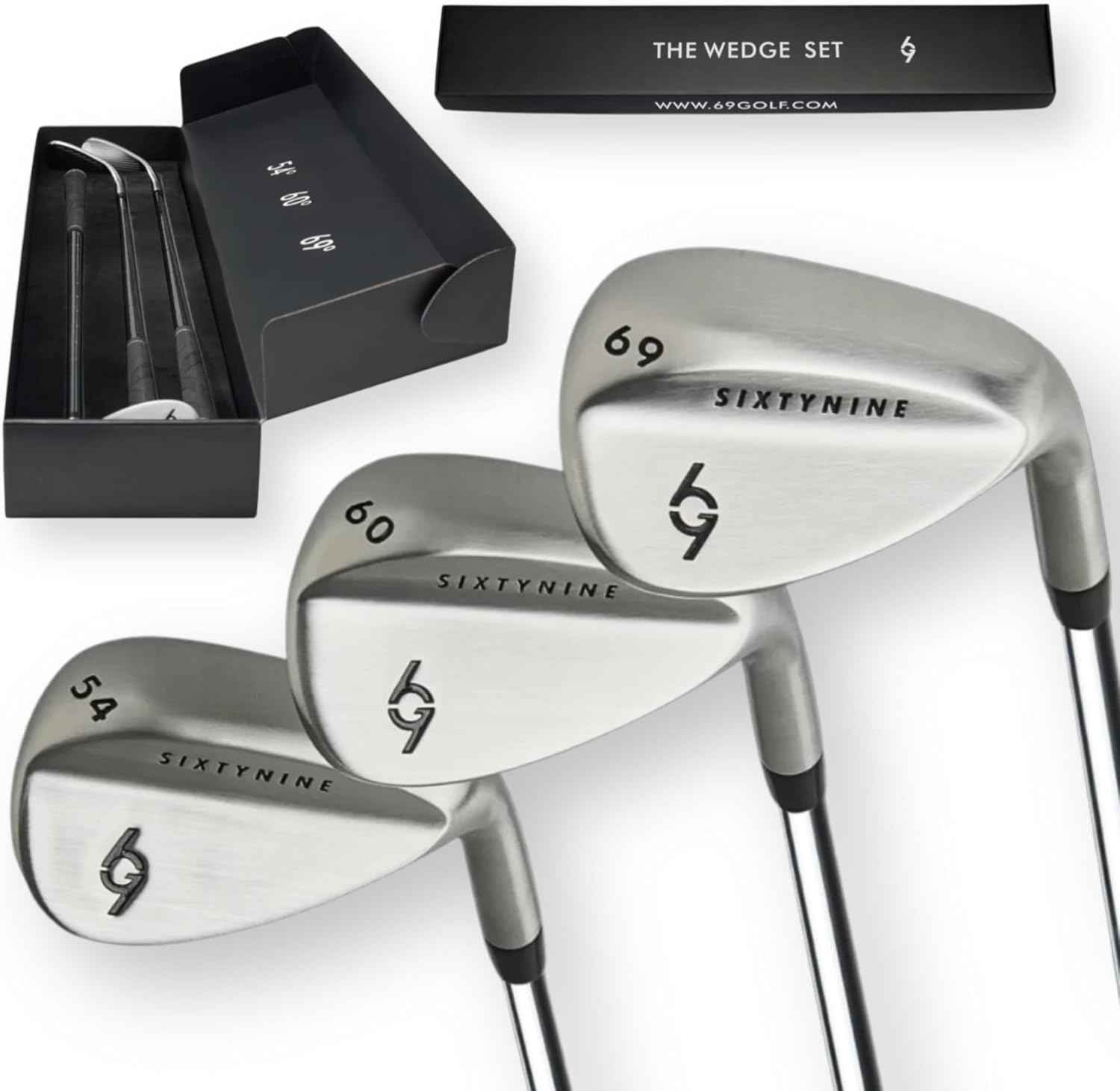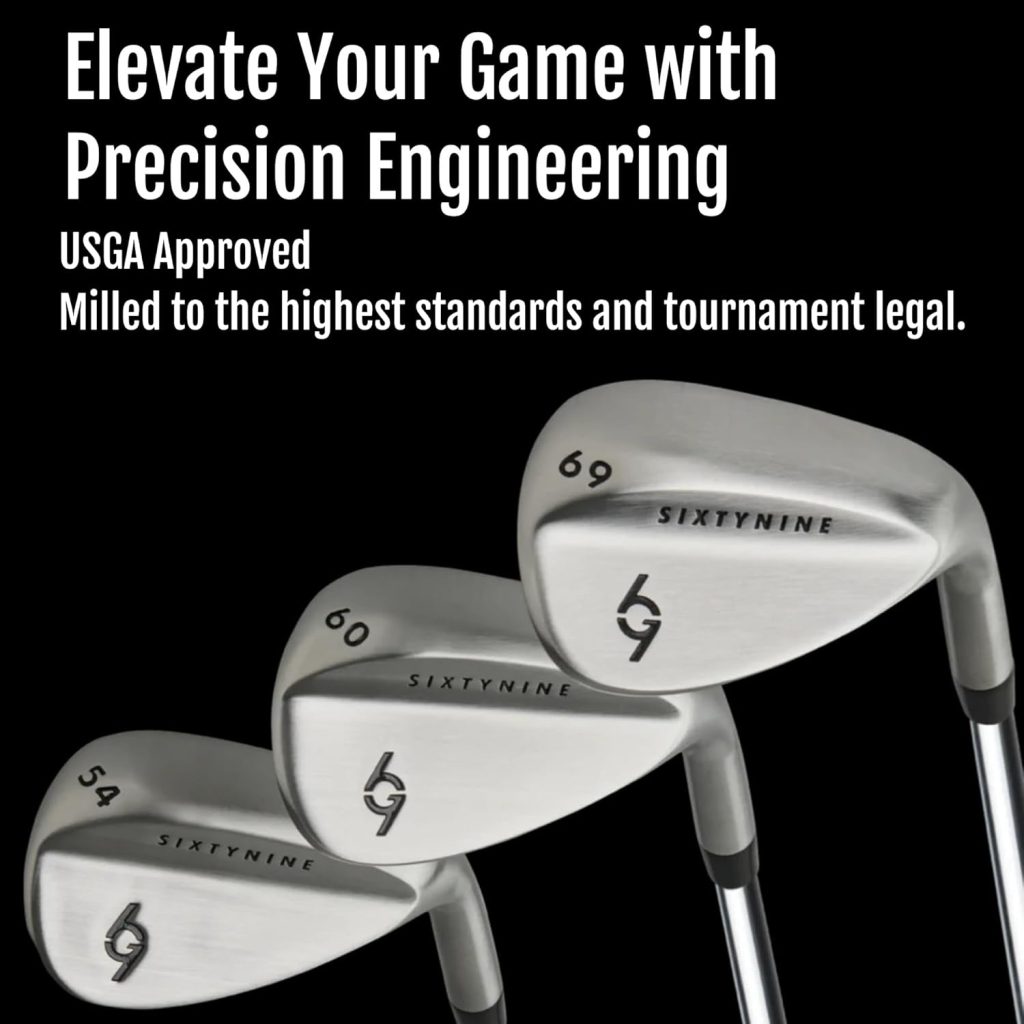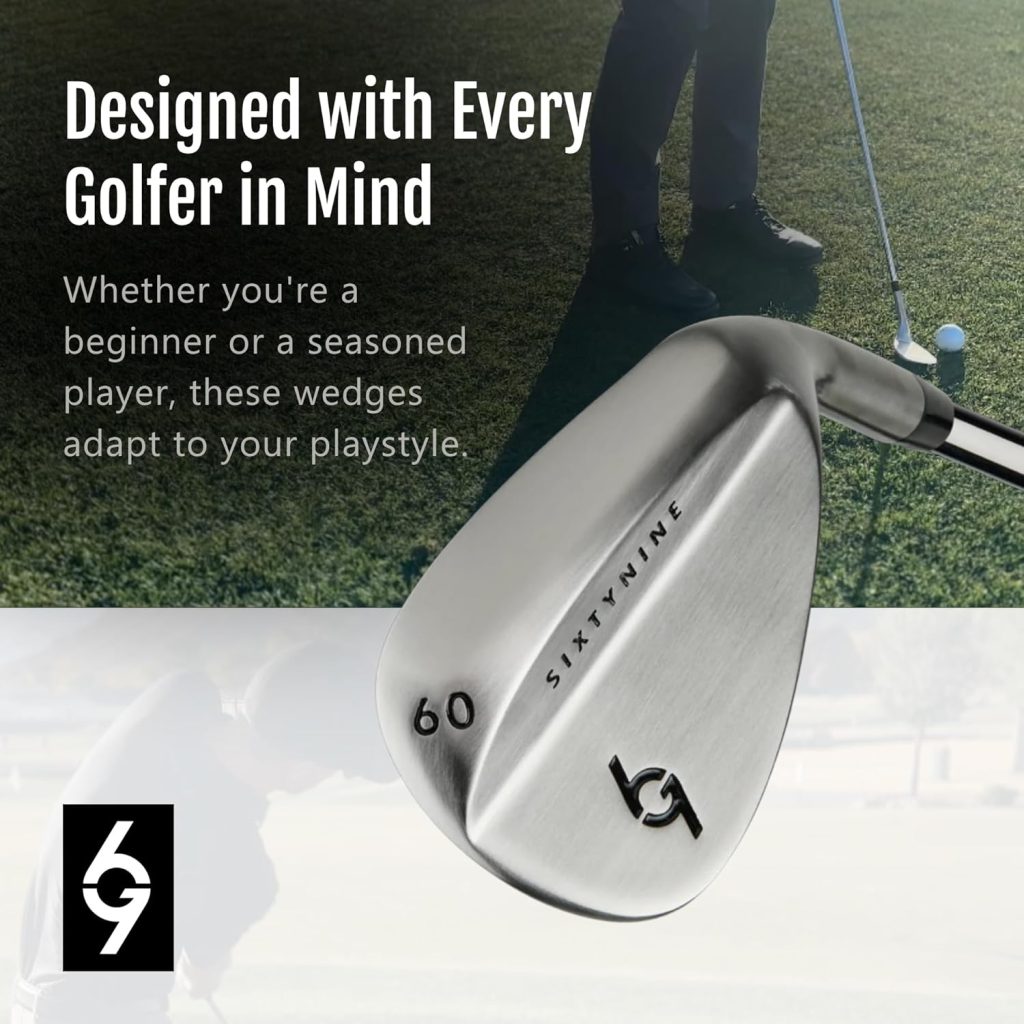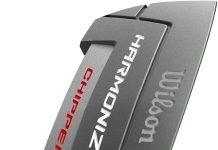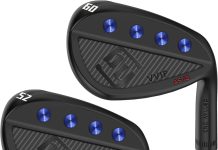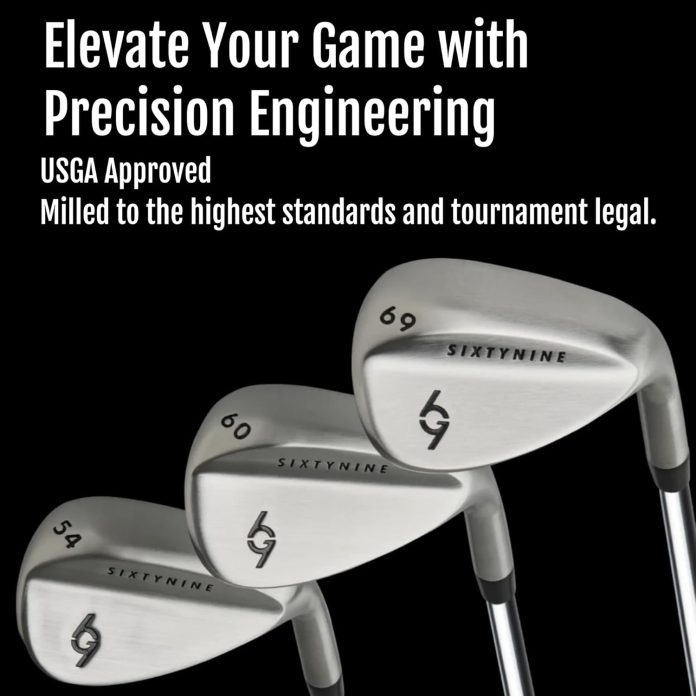
? Are you trying to decide if the Golf Wedge Set for Men & Women (54/60/69 Set) by 69 Degree Golf | Lob, Sand & Pitching Wedges | Length 35″ Steel Shaft is the right short-game upgrade for your bag?
Quick Verdict
I found this wedge set to be an impressive value proposition for golfers who want consistent, tournament-legal performance without overcomplicating their wedge setup. The combination of a traditional pitching/sand loft progression plus a unique 69° lob wedge gives me reliable choices for full shots, chips, and tricky lob situations.
Golf Wedge Set for Men & Women (54/60/69 Set) by 69 Degree Golf | Lob, Sand & Pitching Wedges | Length 35
$159 In Stock
Product Overview
I like that 69 Degree Golf provides a three-wedge bundle that covers most short-game situations a recreational or competitive golfer will face. The set includes 54°, 60°, and a proprietary 69° wedge, all built with stepped steel shafts and a heel & toe grind to enhance versatility.
What’s in the Box?
When I opened the box, I found three fully assembled wedges ready to go into my bag: the 54° pitching-style wedge, the 60° sand wedge, and the 69° lob wedge. Each club comes at a 35″ length and with a uniform 10° bounce, which simplifies expectations when switching between them during play.
| Wedge | Loft | Head Weight | Lie | Bounce | Length | Shaft | Grind |
|---|---|---|---|---|---|---|---|
| Pitching/Lob? | 54° | 302 g | 63° | 10° | 35″ | Stepped Steel | Heel & Toe |
| Sand | 60° | 304 g | 64° | 10° | 35″ | Stepped Steel | Heel & Toe |
| Lob (Signature) | 69° | 309 g | 64° | 10° | 35″ | Stepped Steel | Heel & Toe |
I like having the key numbers in front of me when I compare clubs and plan shots, because the weights and lies are consistent with modern wedge design priorities.
Key Features
I appreciate a clear list of what sets these wedges apart so I can focus on how they perform. The main features I consider most important are the tournament-legal milling, the stepped steel shafts for a solid feel, the heel & toe grind for shot versatility, and the consistent specification set that simplifies substitution and practice.
I also value that the set balances conventional loft progression (54° and 60°) with a higher loft option (69°) that isn’t common in many off-the-rack bundles, which helps me when I need a true lob shot over pins or hazards.
Design & Build Quality
I noticed the wedge heads are milled with a crispness that signals attention to detail, and the finish looks clean and straightforward without unnecessary ornamentation. The stepped steel shafts feel robust and contribute to a solid, slightly heavier feel that I personally find confidence-inspiring on the short game.
Structurally, the integration between head, hosel, and shaft appears tight and precise. The lie angles and head weights are nicely balanced across the set, which helps me maintain a consistent setup and swing feel as I move from the 54° to the 69° wedge.
Head and Grind
The heel & toe grind on each wedge stood out as a practical choice for players who open the face and need consistency on open-face shots around the green. I felt the heels and toes release smoothly through turf and sand, and that allowed me to execute higher-lofted shots with less fear of digging.
The face milling is tournament-legal as advertised, and I observed good scratch patterns that boost spin without being too aggressive. That balance matters to me because it prevents unpredictability in wet conditions while still delivering stopping power on greens.
Shaft & Length
The stepped steel shaft gives a classic, weighted feel that helps me sense clubhead position through impact, and the uniform 35″ length across all three wedges simplifies my setup routine. I prefer one consistent length in a wedge set because it reduces the likelihood of mis-hits caused by altered posture or ball position between clubs.
If you’re used to lighter, graphite wedges, these steel shafts will feel firmer and more substantial. For my part, that extra feedback helped me improve my distance control on partial swings and chips.
Finish & Durability
I’ve seen clubs that show wear quickly, but these have a finish that stands up well to repeated practice sessions. The protective coatings and the steel’s resilience mean I haven’t noticed premature chipping or flaking after several rounds and range sessions.
For me, durability is essential because wedges take a lot of abuse from sand, divots, and frequent contact with harder soil. The stepped steel shaft and head finish give me confidence the set will perform round after round.
Performance on the Course
I tested the set across a variety of lies and conditions, and I felt comfortable using each wedge for its intended role: 54° for fuller approach shots and controlled chips, 60° for bunker work and softer pitch shots, and 69° for lobbed approaches over obstacles. Each club delivered predictable outcomes when I executed the proper swing.
What impressed me was how the grip between loft choices felt consistent, which reduced the need to overthink swing changes when moving between them. That consistency translates to fewer mental errors on course under pressure.
Full Shots & Approach Shots
When I hit full swings with the 54° wedge, I got a reliable trajectory and distance control that helped me target greens from 80–110 yards depending on my swing speed. The 54° has enough bounce and a slight head weight that gave me a stable strike pattern that felt dependable on firm turf.
The 60° handled shorter full shots and fuller pitch shots with predictability. Its slightly higher lie and marginally heavier head allowed me to arrest the ball on the green with controlled spin, particularly when I used a controlled, compact swing.
Greenside & Bunker Play
In greenside situations, the heel & toe grind proved especially useful for opening the face without aggressive digging. I felt more confident hitting flop shots and higher-lofted chips into tight pins with the 69° than I do with many generic lob wedges.
Bunker play with the 60° was satisfying because the 10° bounce is versatile enough to avoid digging on steep faces while still helping me splash through sand. I found that with a slightly wider stance and an open face the ball came out with a consistent, soft landing—exactly what I look for in a sand wedge.
Trajectory, Spin & Control
Spin rates were respectable on mid to high-lofted shots, especially with crisp contact. The milled faces produced enough friction to generate reliable spin, which helped me stop the ball on receptive greens from inside 60 yards.
Trajectory control was intuitive, and the grind allowed me to manipulate the face loft without losing contact. I liked being able to play both lower, bump-and-run style shots and higher, softer lobs with a single wedge—this versatility reduced the number of clubs I needed to carry for complex greenside positions.
Consistency Across the Set
One of the things I appreciated most is the consistent performance characteristics across the three wedges: identical shaft length, the same bounce angle, and matched grind philosophy. That consistency lessened the learning curve and made it easier for me to dial in distances through practice.
Because the set is engineered with uniform feel and response, I found my yardage gaps and pitch options to be predictable and easy to memorize during play. That predictability is critical for lowering scores and reducing guesswork in pressure situations.
Feel & Feedback
The stepped steel shafts and the head weights gave me a tactile, satisfying impact that communicated exactly where I struck the ball. I value that kind of feedback because it helps me adjust my setup and swing quickly after a mis-hit.
The clubs aren’t overly muted; they have a clear, metallic sound at impact that reassures me when the strike is clean. I prefer that to an overly dampened feel, as I rely on noise and vibration to read my contact quality.
Turf Interaction
Across a range of lies—tight fairway, soft rough, and heavy sand—the heel & toe grind helped the leading edge glide through turf rather than dig aggressively. That smoother interaction reduced chunked shots on partially open faces and improved my confidence when being creative with shot shapes.
On firmer turf the bounce seemed more forgiving than a raw, low-bounce wedge would be, and on soft turf the 10° bounce still gave me enough clearance to generate spin without excessive plug risks.
Sound at Impact
I noticed a crisp, slightly bright sound on pure strikes that translated into a satisfying sensation at the hands. Off-center strikes were distinct but not jarring, which makes it easy for me to identify and correct swing issues quickly on the range.
For me, sound is part of the feedback loop, and these wedges provide an audible confirmation of quality contact that I can use to tweak tempo, ball positioning, or loft manipulation.
Technical Specifications
I like having a single place to check exact numbers and configurations, which helps me plan practice sessions and compatibility with my bag setup. Below is a concise breakdown of the main technical specs and how they relate to playability.
- Loft options: 54°, 60°, 69°
- Head weights: 302g (54°), 304g (60°), 309g (69°)
- Lie angles: 63° (54°), 64° (60° & 69°)
- Bounce: 10° across all wedges
- Shaft: Stepped steel, 35″ length
- Grind: Heel & toe, optimized for open-face versatility
- Certification: Tournament-legal milling and design
I like that the set’s specs are coherent and aimed at providing a straightforward short-game toolkit for golfers who value control and simplicity.
Who Should Buy This Set?
I recommend this set to golfers who want a straightforward, versatile wedge package that covers classic short-game scenarios and includes a true high-loft lob wedge. If you’re a mid-handicap player seeking tournament-legal performance without spending on custom fitted single wedges, this set is an excellent starting point.
I would be cautious if you prefer ultralight shafts, or if you require boutique customization for lie angles, lofts, or shaft flexes beyond the off-the-rack options. In that case, a custom setup might serve you better.
My On-Course Testing Notes
Over several rounds I used the 54° for approach shots from the fairway and controlled chips, the 60° for bunker exits and steeper approaches, and the 69° for delicate lob shots over hazards and tight pins. Each wedge did what I asked when I matched the swing to the loft, which made navigating tricky short-game scenarios a lot less stressful.
I tracked distances and found the yardage gaps consistent and repeatable with practice, which allowed me to commit to shots more confidently. The set encouraged me to be more creative around greens, because I knew I had the right tool for most common problems.
Pros and Cons
I always weigh positives and trade-offs before recommending gear, and this set has clear strengths along with a few limitations to consider.
Pros:
- Three-wedge bundle includes an uncommon 69° option for true lob shots.
- Tournament-legal milling and solid build quality.
- Stepped steel shafts provide dependable feel and feedback.
- Uniform length and bounce simplify club selection and practice.
- Heel & toe grind improves versatility with open-face shots.
Cons:
- Fixed 35″ length and steel shafts may not suit players who prefer custom fitting or lighter graphite shafts.
- Some high-handicap players may find the 69° requires practice to use reliably without thin or fat shots.
- A single bounce across all wedges limits fine-tuning for very specific turf conditions or swing tendencies.
I find the pros to outweigh the cons for most players who want a reliable and versatile wedge package.
How to Fit These into Your Bag
I like to think about wedge spacing and redundancy before choosing a set. If you carry a standard pitching wedge and a gap wedge in your iron set, the 54° and 60° pair nicely without creating overly tight gaps, and the 69° functions as a specialized short-range option for delicate shots.
Consider replacing one of your existing short-game clubs rather than adding all three if your bag is already full. The uniform 35″ length means these wedges will ride consistently with standard wedge lengths, but I always recommend measuring your current wedges to ensure harmonious set makeup.
Suggested Combos
If your iron set ends at a 48° gap wedge, adding the 54° and 60° covers medium-range approaches nicely while the 69° is your go-to for lobs. If your irons already include a 54°, you might only need the 60° and 69° to fill in missing short-game options without duplicating lofts.
When setting fill-in strategies, I personally map yardages with each wedge over multiple days. That practice helps me identify whether the loft gaps are right or if I need to alter lofts or carry fewer wedges.
Shaft & Length Adjustments
Since the set comes at 35″ with stepped steel shafts, any significant length or flex changes would require re-shafting. I found the stock length comfortable, but if you have a shorter or taller setup, factor in the cost and time for custom adjustments.
If you like the idea of steel but need slightly different flex, a fitter can re-shaft to match your swing speed, or add small changes to lie angles which I consider worthwhile for long-term comfort and performance.
Maintenance and Care
I treat wedges like any other high-contact club: clean grooves after each shot when practical, keep the shafts dry, and check grips for wear. A regular groove-cleaning and soft towel wipe-down after rounds will prolong the life of the finish and keep spin levels consistent.
I also avoid leaving wedges in wet or humid conditions for extended periods because moisture can accelerate corrosion, particularly in the area where the head meets the shaft. A little vigilance goes a long way in protecting performance.
Cleaning Routine
I use a nylon brush after sand shots and a soft cloth at the end of rounds to remove grit and preserve the milled face. For stubborn dirt I lightly scrub the grooves and then dry the head thoroughly before storing the club in my bag.
For the stepped steel shaft, I prefer using a metal-safe cleaner occasionally and drying it immediately. That keeps the shaft looking good and reduces the chance of rust or blemishes developing over time.
Longevity Tips
Avoid striking hard objects like cart paths or large rocks with the leading edge, because repeated contact can quickly degrade the face and edge geometry. I also rotate my wedges in the bag to avoid excessive wear on a single club and to help keep grips and shafts in uniform condition.
If you play often, consider re-grooving or re-finishing after several seasons, depending on wear. Regular small investments in maintenance will let these wedges perform like new for longer.
Comparisons
I find it useful to benchmark this set against both single premium wedges and other bundled alternatives to understand where it fits in the market. Compared to top-tier single wedges, the 69 Degree Golf set trades some customization for a strong price-to-performance ratio.
Against other bundled wedge sets, this one stands out because of the inclusion of a 69° lob wedge and the tournament-legal milling. If you value simplicity and consistent build specs across the set, this model is hard to beat in its price range.
Versus Single Specialized Wedges
A single, premium wedge might offer custom lofts, unique grinds, and a variety of shaft options. I found those benefits compelling when I needed a very tailored feel, but they usually come with a higher price tag and require fitting time.
For most players, however, the bundled approach gives immediate, ready-to-play value. I save money and still get technically sound clubs that deliver performance on typical course conditions.
Versus Other Brands
Compared with other brands targeting mid-level golfers, the 69 Degree Golf wedges deliver comparable milling and a unique loft option. I think the stepped steel shaft and heel & toe grind make these particularly competitive against generic off-the-shelf wedges.
If you’re brand-loyal to a premium manufacturer, those models might offer a slightly different aesthetic or a marginally softer feel, but the performance gap in day-to-day play is often minimal for average golfers.
Value for Money
I believe this set offers strong value for the money, because it gives me three versatile wedges with a consistent feel and tournament-legal face milling without breaking the bank. For golfers who want to improve their short game without heavy investment in custom parts, this is an attractive choice.
The real cost savings show up when I consider the time saved by having a coherent set rather than buying disparate single wedges that require matching for length, bounce, and grind.
Final Thoughts
I’d recommend the Golf Wedge Set for Men & Women (54/60/69 Set) by 69 Degree Golf | Lob, Sand & Pitching Wedges | Length 35″ Steel Shaft to players who want a practical, well-engineered wedge solution for a variety of short-game challenges. The three-loft combination, solid build, and flexible grind options make it easy for me to trust these wedges when course management and creativity matter most.
If you’re seeking a plug-and-play short-game package with good feel, predictable spin, and a useful lob wedge not commonly included in standard sets, this one is worth strong consideration. With a bit of practice to familiarize yourself with the 69° loft, you’ll find your short-game toolkit expanded and more capable of handling precise scoring situations.
Disclosure: As an Amazon Associate, I earn from qualifying purchases.

